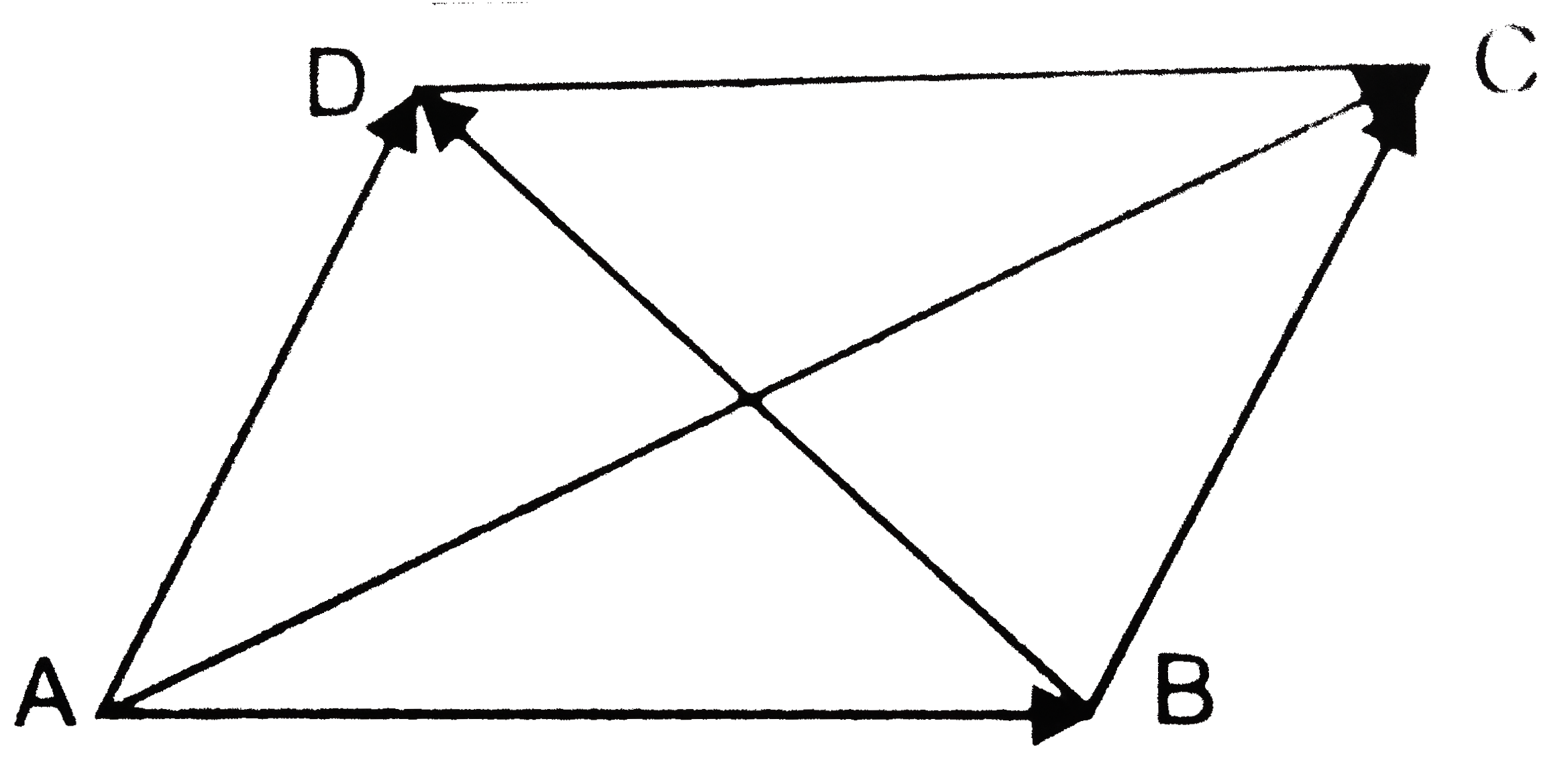ABCD is a parallelogram and AC, BD are its diagonals. Show that :
−−→AC+−−→BD=2−−→BC,−−→AC−−−→BD=2−−→AB.
To solve the problem, we need to show that for the parallelogram ABCD with diagonals AC and BD, the following two equations hold:
1. →AC+→BD=2→BC
2. →AC−→BD=2→AB
1. Define the Vectors:
- Let →A, →B, →C, and →D be the position vectors of points A, B, C, and D respectively.
- The vectors representing the sides of the parallelogram can be defined as:
- →AB=→B−→A
- →BC=→C−→B
- →CD=→D−→C
- →DA=→A−→D
2. Express the Diagonals:
- The diagonal →AC can be expressed as:
→AC=→C−→A
- The diagonal →BD can be expressed as:
→BD=→D−→B
3. Using the Properties of Parallelograms:
- In a parallelogram, opposite sides are equal and parallel. Thus, we have:
→AB=−→CDand→BC=−→DA
- This means:
→CD=→B−→Aand→DA=→C−→B
4. Calculate →AC+→BD:
- Substitute the expressions for →AC and →BD:
→AC+→BD=(→C−→A)+(→D−→B)
- Rearranging gives:
=→C+→D−→A−→B
- Since →D=→C+→B−→A (from the properties of the parallelogram), we can substitute:
=→C+(→C+→B−→A)−→B−→A
- This simplifies to:
=2→BC
5. Calculate →AC−→BD:
- Now, we calculate →AC−→BD:
→AC−→BD=(→C−→A)−(→D−→B)
- Rearranging gives:
=→C−→A−→D+→B
- Substitute →D=→C+→B−→A:
=→C−→A−(→C+→B−→A)+→B
- This simplifies to:
=2→AB
Conclusion
We have shown that:
1. →AC+→BD=2→BC
2. →AC−→BD=2→AB
2. →AC−→BD=2→AB
- Let →A, →B, →C, and →D be the position vectors of points A, B, C, and D respectively.
- The vectors representing the sides of the parallelogram can be defined as:
- →AB=→B−→A
- →BC=→C−→B
- →CD=→D−→C
- →DA=→A−→D
- The diagonal →AC can be expressed as:
→AC=→C−→A
- The diagonal →BD can be expressed as:
→BD=→D−→B
- In a parallelogram, opposite sides are equal and parallel. Thus, we have:
→AB=−→CDand→BC=−→DA
- This means:
→CD=→B−→Aand→DA=→C−→B
- Substitute the expressions for →AC and →BD:
→AC+→BD=(→C−→A)+(→D−→B)
- Rearranging gives:
=→C+→D−→A−→B
- Since →D=→C+→B−→A (from the properties of the parallelogram), we can substitute:
=→C+(→C+→B−→A)−→B−→A
- This simplifies to:
=2→BC
- Now, we calculate →AC−→BD:
→AC−→BD=(→C−→A)−(→D−→B)
- Rearranging gives:
=→C−→A−→D+→B
- Substitute →D=→C+→B−→A:
=→C−→A−(→C+→B−→A)+→B
- This simplifies to:
=2→AB
We have shown that:
1. →AC+→BD=2→BC
2. →AC−→BD=2→AB
Topper's Solved these Questions
- VECTOR ALGEBRA BOOK - MODERN PUBLICATIONCHAPTER - VECTOR ALGEBRA EXERCISE - EXERCISE 10 (c ) Short Answer Type Questions
39 Videos
- VECTOR ALGEBRA BOOK - MODERN PUBLICATIONCHAPTER - VECTOR ALGEBRA EXERCISE - EXERCISE 10 (c ) Long Answer Type Questions (I)
12 Videos
- VECTOR ALGEBRA BOOK - MODERN PUBLICATIONCHAPTER - VECTOR ALGEBRA EXERCISE - EXERCISE 10 (a) Short Answer Type Questions
21 Videos
- THREE DIMENSIONAL GEOMETRY BOOK - MODERN PUBLICATIONCHAPTER - THREE DIMENSIONAL GEOMETRY EXERCISE - CHAPTER TEST 11
11 Videos
Similar Questions
Knowledge Check
ABCD is a parallelogram with AC and BD as diagonals. Then, A→C−B→D=
A4A→BB3A→BC2A→BDA→BIf ABCD is a parallelogram, then −−→AC−−−→BD=
A4−−→ABB3−−→ABC2−−→ABD−−→AB
A parallelogram ABCD. Prove that −−→AC+−−→BD=2−−→BC'
View SolutionABCDE is a pentagon prove that −−→AB+−−→BC+−−→CD+−−→DE+−−→EA=→0
View SolutionIf ABCDEF is a regular hexagon, prove that −−→AC+−−→AD+−−→EA+−−→FA=3−−→AB
View SolutionPQRS is a parallelogram and −−→QS and −−→PR are its diagonals .Show that
−−→PR+−−→QS−2−−→QR=0
View SolutionIf A,B,C,D are any four points in space prove that −−→AB×−−→CD+−−→BCx−−→AD+−−→CA×−−→BD=2−−→AB×−−→CA
View SolutionIn a regular hexagon ABCDEF, prove that −−→AB+−−→AC+−−→AD+−−→AE+−−→AF=3−−→AD
View Solution

 .
.